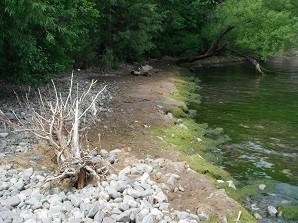MakingWaves - CREEQ Research Initiative; Report Cladophora; Great Lakes Partners & Projects Webinar; Lake Management Webinar; Harmful Algal Boom Notifications
The New York State Department of Environmental Conservation sent this bulletin on 06/12/2020 03:33 PM EDT |
| DEC Delivers - Information to keep you connected and informed from the NYS Department of Environmental Conservation |
| Share or view as a web page || Update preferences or unsubscribe |
MakingWaves - News from the Division of Water |
In this Issue:
Volunteers Needed for SUNY ESF Research Project in Central New YorkThe Division of Water encourages people who recreate on or near waterways in central New York to participate in the Citizen Recreational Evaluation of Environmental Quality (CREEQ) citizen-science initiative. The CREEQ initiative is a research project by the SUNY College of Environmental Science and Forestry sponsored by DEC. You can support this environmental science research by reporting the condition of the waterways you visit through a guided online survey. The CREEQ project is for waterways in the following counties: Broome, Cayuga, Chenango, Cortland, Herkimer, Jefferson, Lewis, Madison, Oneida, Onondaga, Ontario, Otsego, Oswego, Seneca, Schuyler, Tioga, Tompkins, Wayne, and Yates counties. For more information, view the CREEQ Call for Citizen Scientists flyer (PDF). Report Cladophora in the Great Lakes
Cladophora is a type of stringy (filamentous) algae that grows on rocks, wood, logs, and other hard underwater surfaces in freshwater ecosystems, including the Great Lakes basin. If you spot this type of stringy algae along New York's Great Lakes beaches and shorelines, including Lake Erie, Lake Ontario, the Niagara River or the St.Lawrence River, DEC wants to know. Please share your observations using this online reporting tool. The information collected will assist with efforts in the U.S. and Canada under the Great Lakes Water Quality Agreement that aim to provide a better understanding of where, when, and the extent to which Cladophora is accumulating along the Great Lakes shorelines. Additional information about Cladophora can be found on DEC’s Cladophora webpage. For questions and to find out more about sharing your observations, contact GLCladophora@dec.ny.gov. Great Lakes Action Agenda Partners & Projects June 16th WebinarDEC's Great Lakes Program invites you to "sign on" this summer to learn about partners & projects working to protect, restore and enhance our Great Lakes lands and waters and funding opportunities to advance additional projects in support of NY's Great Lakes Action Agenda (GLAA). The first webinar will be held June 16 at 2 p.m. Learn about NY’s ecosystem-based approach to keeping our Great Lakes waters healthy, plus what has been achieved and what remains to be accomplished. For more information, view the GLAA Webinar Series Flyer. Lake Management Webinar: Conflict Management for OrganizationsThe Syracuse University Environmental Finance Center (EFC) and the NY Federation of Lake Associations (FOLA) have announced a free series of webinars to enhance the skills of municipal and lake association leaders to better manage lakes in their jurisdictions. The second webinar in this series will be held June 18, 10 a.m. to 11 a.m. Attend this webinar to learn from a Syracuse University expert how to transform conflict into opportunity. Register now for the June 18 webinar. For more information about the webinar series, visit EFC's webpage. Harmful Algal Bloom (HAB) NotificationsVisit NYHABS, DEC’s harmful algal bloom notification map, to view locations of current freshwater HABs in New York State. Each yellow dot on the map represents a HAB reported in the past two weeks. Click on a dot for more information, including the date it was reported, the waterbody name, and pictures. Click on the arrow at the bottom of the screen to view a list of reported HABs. Know it. Avoid it. Report it. If you see a HAB, please use the reporting form to submit a report to NYHABS. Because waterbodies may have HABs that have not been reported to DEC, we recommend avoiding contact with floating mats, scums and discolored water. If you, your family, or pet have been in contact with a HAB, please rinse with clean water and report any symptoms to your local health department.
|


